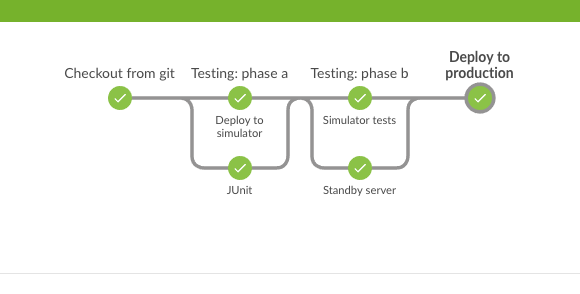Continuous delivery is a methodology where each commit can potentially get into production in a timely manner.
Jenkins Pipeline is one of the tools out there that automates the delivery process to make it short, robust, and without human intervention as much as possible.
We have recently done such an integration on our team at Outbrain, so here are some tips and advises from our humble experience.
X. You should have done this ages ago (so do it today)
Don’t wait till you have all the building blocks in place. Start with a partial pipeline and add all the automated steps you already have in place. It will give you the motivation to add more automation and improve the visibility of the process.
The pipeline set of plugins in Jenkins are ~1 year old in its current form, So it is mature and well documented. Definitely ready to use.
X. Validate artifacts and source code consistency across pipeline
That tip I read in the Teamcity pipeline post but is relevant for Jenkins as well. Make sure that the same version of sources and artifacts is used across all stages. Otherwise, commit might be pushed while the pipeline is executing, and you might end up deploying untested version.
X. Use commit hook with message regexp
Well, if I will try to generalise this tip I would say: try to ask for as little human intervention as possible (when it is not required). A good place to start is a commit hook. It works in a way that when a developer push code with a specific commit message — in our case #d2p (deploy to production), the pipeline is automatically triggered.
Here is a code sample from Jenkinsfile (the pipeline configuration file):
gitCommitMessage = sh(returnStdout: true, script: 'git log -1 --pretty=%B').trim() deployToProd = (gitCommitMessage =~ /#d2p/ || params.DEPLOY_TAG == "#d2p") //we also allow '#d2p' when triggering manually
X. Try the Blue Ocean view
Blue Ocean set of plugins are in release-candidate stage as of the time of writing (now it is GA). Stable enough and a very good UI— especially for parallel stages. So I would recommend using. In addition, it is working side-by-side with the old UI.


X. Ask for user authorization on sensitive operations
If you still not sure that your monitoring system is robust enough, start by automating the pipeline, and ask for developer authorization before the actual deploy to production.
Here is a code sample from Jenkinsfile:
timeout(time:5, unit:'HOURS') {
input message: 'Deploy to production?', ok: 'Deploy!'
}
X. Integrate slack or other notifications
Slack is awesome and has a very documented API as well. Sending notifications on pipeline triggering and progress helps to communicate the work between team members. We use it to send start, completed, and failure notifications right now. We plan to integrate the above approval input with a slack bot so we can approve it directly from slack.

X. Make the pipeline fast (parallelize it)
Making pipeline turnaround time short helps to keep work efficient and fun. Set a target for the total turnaround time. Our target is less than 10 minutes. One of the easiest ways to keep it fast is by running stages that are independent in parallel. For example, we run a deployment to a test machine in parallel to the integration tests and deployment to a canary machine in parallel to our black-box tests.
Here is a code sample from Jenkinsfile:
stage("Testing: phase a") {
parallel 'JUnit': {
stage("junit") {
sh '...'
}
}, 'Deploy to simulator': {
stage("Deploy to simulator") {
sh '...'
}
}
}
stage("Testing: phase b") {
parallel 'Simulator tests': {
stage("Simulator tests") {
sh '...'
}
}
}, 'Canary server': {
stage("Deploy to canary") {
sh '...'
}
stage("Tests on canary") {
sh '...'
}
}
}
X more tips in the great post below:
Enjoy Piping!
P.S. – The original post was published on my personal blog
I am going to have a talk at Jenkins Use Conference that is based on this blog post
You are welcome to there for more details!